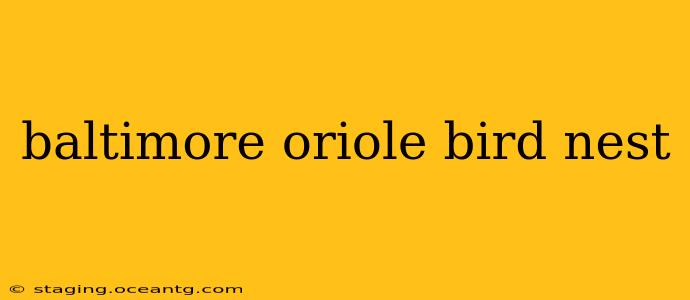The Baltimore Oriole ( Icterus galbula) is renowned not only for its vibrant plumage but also for its intricately woven nests. These aren't your typical bird nests; they're hanging masterpieces, often described as exquisite works of avian architecture. Understanding these nests, from their construction to their location, offers a fascinating glimpse into the world of these beautiful birds.
What do Baltimore Oriole nests look like?
Baltimore Oriole nests are distinctive, easily recognizable by their deep, pouch-like shape. They're primarily constructed from plant fibers, often incorporating grasses, string, threads, and even bits of yarn or other man-made materials if available near the nest site. The birds meticulously weave these materials together, creating a strong, flexible cup that hangs securely from a tree branch, usually high up and well-concealed within the foliage. The outside is often quite rough, reflecting the variety of materials used, while the inside is more finely woven and smoothly lined, creating a comfortable cradle for their eggs.
Where do Baltimore Orioles build their nests?
Orioles prefer to build their nests in the upper branches of deciduous trees, often choosing species like elm, oak, ash, and maple. They favor trees with a strong, forked branch that allows for secure hanging of the nest. The location is usually high up, offering protection from predators and providing ample shade. While they might use other trees, the preference is consistently for tall trees with strong, overhanging branches. The location also needs to provide sufficient cover for the nest to remain hidden from potential dangers.
What kind of materials do Baltimore Orioles use to build their nests?
The building materials used by Baltimore Orioles are varied but consistently plant-based fibers. These include long grasses, plant fibers, twine, and even strips of bark. Interestingly, they often incorporate human-made materials into their nests, such as string, yarn, or pieces of cloth if found nearby. This adaptability demonstrates their intelligence and ability to utilize available resources. The choice of material can also depend on the availability in their immediate environment, with some nests showcasing a greater diversity of materials than others.
How long does it take a Baltimore Oriole to build a nest?
Building a Baltimore Oriole nest is a labor-intensive process. It typically takes a female Baltimore Oriole, who undertakes the majority of the construction, approximately 5-7 days to complete the nest. This time frame can vary depending on several factors, including the availability of materials and weather conditions. The precision and care taken during construction are evident in the final product.
Are Baltimore Oriole nests reused?
Baltimore Oriole nests are generally not reused. Unlike some bird species that may renovate and reuse their nests year after year, Baltimore Orioles typically construct a new nest each breeding season. This ensures the nest's structural integrity and hygiene for the new clutch of eggs.
Do Baltimore Orioles build nests in birdhouses?
While Baltimore Orioles are not known for regularly utilizing birdhouses, they may occasionally use them if appropriately designed. A birdhouse should be specifically designed to accommodate the hanging nature of their nest; a typical, enclosed box will likely be avoided. Open-fronted, cup-shaped birdhouses with a significant degree of overhead cover and protection might be considered, but their natural preference remains for building their own nests in trees.
How can I attract Baltimore Orioles to my yard?
Attracting Baltimore Orioles to your yard involves providing a suitable habitat and abundant food sources. Planting native trees and shrubs that offer good nesting sites and protection is vital. They are particularly attracted to trees with strong, overhanging branches. Supplementing their diet with orange slices, grape jelly, or specialized nectar feeders can help attract them to your property. The provision of a water source is also essential.
By understanding the nuances of Baltimore Oriole nests – their construction, materials, location and overall design – we gain a deeper appreciation for these clever, beautiful birds and the fascinating world of avian architecture. Their nests serve as a testament to the remarkable ingenuity and dedication found in the natural world.
